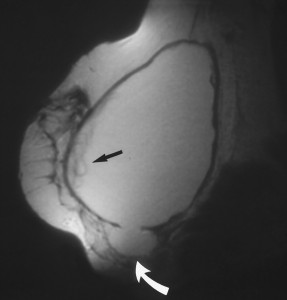Some prospective breast augmentation patients are surprised to learn that breast implants – saline or silicone – don’t last forever. So, how long do breast implants last? Manufacturers say their products should last about 10 years, on average. However, surgeons can cite patients whose implants fail at 5 years and others that are in fine shape after 25 years. The point is, how do you monitor implants along the way?
by Brad Bengtson, MD
The Plastic Surgery Channel
 New Tech for Better, Faster Results
New Tech for Better, Faster Results
Dr. Brad Bengtson of Grand Rapids, Michigan is a strong proponent of High Resolution Ultrasound (HRUS). In the last 8 years, he has used high resolution ultrasound on hundreds of his breast augmentation patients as part of his follow up. He emphasizes that ultrasound is a simple, more accurate, and definitely less costly than an MRI. “When the FDA reapproved silicone implants in 2006, they recommended an MRI at 3, 5, and 7 years and every 2 years after that,” explains Dr. Bengtson. But, in reality, there was less than 1% compliance. “The problem,” he explains is “an MRI is around $2500…and implants (statistically) don’t fail until around year 8…so you already spent $5000 imaging something that doesn’t need to be imaged.”
HRUS is dynamic, not a single snapshot like an MRI
Bengtson contends that high resolution ultrasound imaging is better at detecting breast implant shell failure because contrary to an MRI, it is dynamic, whereas an MRI is a snapshot. Essentially he can manipulate the breast in areas that look suspicious for a rupture or leak. “I can tell a patient within 3 minutes if their breast implant is intact or not. That is incredibly reassuring.” In fact with one exception (a woman with a previous rupture) 100% of Dr. Bengtson’s patients were diagnosed correctly with ultrasound. Apart from the confidence factor, the cost consideration is a moot point. Bengtson wraps the costs of all his ultrasound follow up into the initial surgery fee. Unless there is a case of trauma, such as a car accident or a fall, he recommends patients see him year 7 or 8, and then every other year after.
According to Dr. Bengtson, the key to ultrasound is the transducer–the hand held piece. Ultrasound emits a very high transmission level and since the implant is just a few centimeters below the skin, it is incredibly accurate. In fact, newer versions of the technology now offer color coding. For instance, the operator can designate the shell as blue, the capsule as white and the gel as pink. Should there be a rupture, the pink would be poking through the blue.
“Current ultrasound technology is very straightforward.” Bengtson is quick to add plastic surgeons are certainly not radiologists, “The only thing we are evaluating with ultrasound is the implant itself, we are not looking for any breast masses or cysts.” We have studied more than 400 patients now and if the implant appears intact we are 100% accurate, if ruptured we have a 93% accuracy. If there is a question about a rupture, or we are evaluating an older device, I may send the patient to a radiologist for confirmation.”
Dr. Bengtson’s initial interest in ultrasound for implants was inspired by the images he saw of his unborn son. The quality of the visuals inspired him to think, There must be some application for our specialty. Today, he is incredulous that ultrasound isn’t part of every plastic surgery practice since it is so widely used in every other specialty. But that, he contends, is only a matter of time. “At some point, ultrasound will become just an extension of our physical exam.”

 New Tech for Better, Faster Results
New Tech for Better, Faster Results













Facebook
Twitter
Instagram
YouTube
RSS